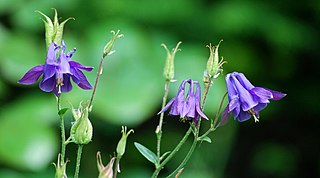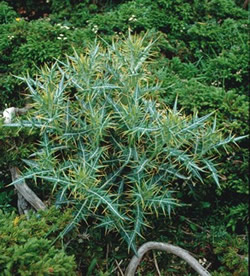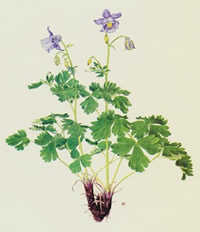
Aquilegia is a genus of about 130 species of perennial plants that are found in meadows, woodlands, and at higher elevations throughout the Northern Hemisphere, known for the spurred petals of their flowers.

Lamyropsis microcephala is a species of flowering plants in the family Asteraceae. It is found only on the Italian island of Sardinia. Its natural habitat is Mediterranean-type shrubby vegetation. It is threatened by habitat loss.

Aquilegia barbaricina, common name Barbaricina columbine, is a perennial species of flowering plant in the family Ranunculaceae. It is endemic to Italy, occurring only on the island of Sardinia.

Aquilegia nuragica, commonly called Nuragica columbine, is a perennial flowering plant in the family Ranunculaceae. It is endemic to Italy, in a single canyon in the Supramonte mountain range on the island of Sardinia.

Aquilegia eximia, the serpentine columbine or Van Houtte's columbine, is a perennial species of flowering plant in the family Ranunculaceae, endemic to California.

Aquilegia micrantha var. grahamii, common name Graham's columbine, is a variety of perennial flowering plant in the family Ranunculaceae, endemic to Utah in the United States.
Aquilegia incurvata, or the Qinling columbine (秦岭耧斗菜), is a perennial species of flowering plant in the family Ranunculaceae, endemic to the Qinling mountain range in China.

Aquilegia lactiflora is a perennial species of plant in the family Ranunculaceae, native to Central Asia and the Himalayas.
Aquilegia litardierei is a perennial species of plant in the family Ranunculaceae, endemic to Corsica.
Aquilegia aradanica is a perennial flowering plant in the family Ranunculaceae, endemic to Siberia.
Aquilegia aragonensis is a perennial flowering plant in the family Ranunculaceae, endemic to northern Spain.

Aquilegia barykinae is a perennial flowering plant in the family Ranunculaceae, endemic to the Russian Far East. The species was first described in 2014. Its flowers are lilac-blue.

Aquilegia bashahrica is a perennial flowering plant in the family Ranunculaceae, endemic to the Himalayas.

Aquilegia cazorlensis is a perennial flowering plant in the family Ranunculaceae, endemic to southeastern Spain.
Aquilegia cymosa is a perennial flowering plant in the family Ranunculaceae, endemic to Pakistan.

Aquilegia daingolica is a perennial flowering plant in the family Ranunculaceae, endemic to Mongolia. The plant's flowers are blue or violet-blue.

Aquilegia dumeticola is a perennial flowering plant in the family Ranunculaceae, native to southeastern Europe.

Aquilegia ganboldii is a perennial flowering plant in the family Ranunculaceae, native to Mongolia, northeast China, North Korea, and Siberia.
Aquilegia grubovii is a perennial flowering plant in the family Ranunculaceae, native to northern Mongolia and Tuva in Russia.
Aquilegia hebeica is a perennial flowering plant in the family Ranunculaceae, native to northern China.












